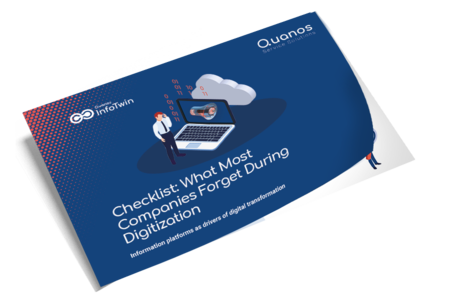Digitalization is the defining factor in most companies' strategies. But surprisingly enough, many overlook an aspect that is key to a digitalization strategy—the central information platform for aftersales information such as product documentation, spare parts catalogs, and service information. A digital information platform lets you link up these various types of information so employees and customers can find them more easily. Here are the five steps you need to take to set up a digital information platform for your company.

Start by thinking about everyone who would need to use a communication platform for aftersales information. You'll quickly realize that this group of people is significantly larger than you might initially think, as it includes technical writers, service technicians, customer support teams, trainers, sales staff, and probably others as well.
Many areas of a business need a central platform that they can use for aftersales communication for one purpose or another. Identify these target groups' information needs and find out which materials are to be made available on the platform. Then define the goals for the platform and identify potential weaknesses.
Based on the results of the requirements analysis, you can now look at selecting a modular cloud solution. Why use a modular cloud solution? Because a modular solution lets you link up all your aftersales information in an intelligent way. And using a cloud-based application means that both your team members and your customers can access the information anytime and anywhere. Plus, the modular design will make it convenient to expand the solution in line with your future needs.
It's worth noting that the rights management feature in the information platform will manage who can see what information. The key task of the information platform, in turn, is providing all the information in a way that actually makes it easy to find. This is why you should pay special attention to usability when choosing a solution.
The usual rules for rolling out any system also apply when introducing the platform: plan carefully and see to it that adequate time and IT resources are available. Think about the approach you will use to transfer content over to the new system, and make sure that all interfaces to other systems are defined. It will then be simple to integrate the relevant sources of the content. Plan the go-live and create the conditions for ongoing monitoring and optimization of the platform.
Even the best information platform won't be much use if your employees and customers aren't familiar with it. So think about what kind of training is needed for content providers and users—keeping in mind that both individual team members as well as groups of employees will require training.
This should be backed up by a communication strategy that ensures users outside the company also know about the platform. The communication strategy should also be designed to collect feedback from users and implement suggestions.
An information platform has to develop and grow with the needs of the company. To achieve this, you need to identify areas for improvement but also measure success. New business models need to be examined to see whether and how they can be implemented in the information platform. And any adjustments and enhancements to the platform functionalities need to be checked according to the same criteria. This will continually enhance the added value the platform offers your company and customers.

A central platform for aftersales information is the key factor in any digitalization strategy. In addition to simplifying communication with employees and customers, it also boosts follow-up business and reduces support costs. We've put together a checklist with the main points involved in each step of introducing a modular cloud solution to help make this an easy process for you. The list is available for download here—so when it comes down to it, you'll know you've thought of absolutely everything for your central information platform!